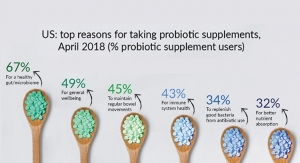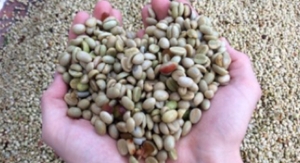05.23.19
Topics like sustainability, plant-based diets and clean eating seem to permeate news about food, but it turns out they’re not just buzzwords or “flavors of the week.” IFIC Foundation’s 2019 Food and Health Survey showed genuine and growing interest in these and other trends.
The 2019 edition marks the 14th consecutive year that IFIC Foundation has surveyed American consumers to understand their perceptions, beliefs and behaviors around food and food-purchasing decisions.
Sustained Interest in Sustainability
Previous Food and Health Surveys asked consumers about their views on sustainability, but their interpretations of the concept varied. This year’s survey got more specific by asking consumers what they look for in order to know whether a product is environmentally sustainable.
Every year the survey identifies leading factors that impact food and beverage purchases. Every survey has seen “taste” reign supreme and in 2019 the trend continues. Deemed important by 86% of consumers, the impact of taste on purchasing decisions is up significantly from 81% in 2018. Other factors such as “price” (68%), “healthfulness” (62%) and “convenience” (57%) held steady. “Sustainability” as a purchase driver registered in the mid- to high-30 percentages through the years, but the 2019 refinement to “environmental sustainability” resulted in a drop to 27%, indicating that consumers may think of more than the environment when it comes to sustainability.
Regardless of the impact on purchasing decisions, over half of consumers (54%) said it’s at least somewhat important that the products they buy be produced in an environmentally sustainable way. Among those 54%, many look for specific labels or attributes to assess whether they believe a product is environmentally sustainable: 51% perceive products that are locally produced as environmentally sustainable, followed by products literally labeled as sustainably produced (47%), labeled as non-GMO/not bioengineered (47%), labeled as organic (44%), having recyclable packaging (41%), and having minimal packaging (35%).
“The IFIC Foundation has been exploring more and more facets of sustainability in recent years, and the trends are unmistakable,” said Joseph Clayton, president and CEO of the IFIC Foundation. “Values-based food decisions—which are sometimes at odds with established scientific consensus—continue to play a growing role in consumer food purchases.”
At the same time, consumers struggle with recognizing environmentally sustainable foods. While environmental sustainability is a lower purchase driver compared to taste, price, healthfulness, and convenience, that number is perhaps at least partially explained by the fact that 63% of consumers said it is hard to know whether the food choices they make are environmentally sustainable. Among that group, nearly two-thirds (63%) said environmental sustainability would have a greater influence on their choices if it were easier to know.
Dietary Trends: Plant-Based and ‘Clean Eating’
Sustainability isn’t the only term that means different things to different people. Even a seemingly straightforward term like “plant-based” is subject to interpretation. About three-quarters (73%) of people said they have heard of plant-based diets, and about half (51%) are interested in learning more about them. Consumers who have tried any diet in the past year are far more likely to have heard of plant-based diets than those who have not tried a diet in the past year (82% vs. 68%).
But consumers were split on what they believe a plant-based diet means. About one-third (32%) said it is a vegan diet that avoids all animal products, including eggs and dairy. A similar percentage (30%) defined it as a diet that emphasizes minimally processed foods that come from plants, with limited consumption of animal meat, eggs, and dairy. Another one in five (20%) believed it to be a vegetarian diet that avoids animal meat, while 8% said it is a diet in which you try to get as many fruits and vegetables as possible, with no limit on consuming animal meat, eggs, and dairy.
Animal products are a more popular source of protein than plants, with 52% of survey takers saying they eat animal protein at least once per day versus 34% who said they eat plant-based protein—but the tide may be turning. Within the past year, 24% of consumers reported eating more plant protein than the previous year, while only half as many (12%) said they ate more animal protein.
Also on the topic of diets, few buzzwords were trendier than eating “clean.” The 2019 Food & Health Survey added “clean eating” as an option to a question about whether consumers have followed any specific diet or eating pattern in the past year. This year, 38% answered “yes,” up slightly from 36% in 2018. “Clean eating” was the most widely cited diet at 10%, followed by intermittent fasting at 9%, then gluten-free and low-carb, both at 6%. The percentage of people that tried ketogenic or high-fat diets doubled (6% in 2019 vs. 3% in 2018), while there were marked declines for people taking up paleo (down to 3% in 2019 from 7% in 2018) and Whole30 (down to 2% from 5%) diets.
“While some diets are trendier or healthier than others, it’s clear a significant segment of consumers are adopting at least some kind of diet,” said Alexandra Lewin-Zwerdling, vice president for research and partnerships at the IFIC Foundation. “Consumers are continuing to seek out diets that align with their personal values while joining communities of other Americans adopting similar habits.”
Getting Technical: Younger Consumers Better Understand Certain Concepts
Consumer awareness and comprehension of some important food and nutrition terms is lacking. Only about one-quarter (23%) of consumers understand “nutrient-density,” which refers to foods with a higher proportion of nutrients and fewer “empty” calories. Nearly three in five (58%) have not even heard of the term. In general, younger consumers reported far greater understanding and awareness of nutrient-density than older ones (34% of those age 18-34 understand it vs. just 9% among those 65 and older).
“Regenerative agriculture” (farming systems that increase biodiversity and improve ecosystems) is another term with low familiarity: Less than one-quarter (22%) of consumers have heard of it, but more than half (55%) are interested in learning more. Similar to nutrient-density, awareness of regenerative agriculture was greater among younger people than older people (34% of those 18-24 had heard the term vs. 13% age 65+).
Trust in Brands and Familiarity with Ingredients
The 2019 survey asked consumers about two new factors that impact food and beverage purchases—trust in a brand and recognition of ingredients that go into a product—and it turns out that both play big roles as purchase drivers. Trust in a brand had a major impact on the purchasing decisions of 30% of consumers (with 70% saying it had at least some impact), only slightly behind price at 33% (with 68% saying price had at least some impact). Interestingly, trust in a brand impacted far more consumers age 65 and above (85%) than younger consumers (66%). At the same time, nearly two-thirds (63%) of consumers said recognizing the ingredients that go into a product had at least some impact on their purchasing decisions.
Methodology
Survey results were derived from an online survey of 1,012 Americans ages 18-80, conducted March 22 to April 9, 2019. Results were weighted to ensure they are reflective of the American population, as seen in the 2018 Current Population Survey. Specifically, they were weighted by age, education, gender, race/ethnicity, and region. The survey was conducted by Greenwald & Associates, using Dynata’s (formerly known as ResearchNow) consumer panel.
The 2019 edition marks the 14th consecutive year that IFIC Foundation has surveyed American consumers to understand their perceptions, beliefs and behaviors around food and food-purchasing decisions.
Sustained Interest in Sustainability
Previous Food and Health Surveys asked consumers about their views on sustainability, but their interpretations of the concept varied. This year’s survey got more specific by asking consumers what they look for in order to know whether a product is environmentally sustainable.
Every year the survey identifies leading factors that impact food and beverage purchases. Every survey has seen “taste” reign supreme and in 2019 the trend continues. Deemed important by 86% of consumers, the impact of taste on purchasing decisions is up significantly from 81% in 2018. Other factors such as “price” (68%), “healthfulness” (62%) and “convenience” (57%) held steady. “Sustainability” as a purchase driver registered in the mid- to high-30 percentages through the years, but the 2019 refinement to “environmental sustainability” resulted in a drop to 27%, indicating that consumers may think of more than the environment when it comes to sustainability.
Regardless of the impact on purchasing decisions, over half of consumers (54%) said it’s at least somewhat important that the products they buy be produced in an environmentally sustainable way. Among those 54%, many look for specific labels or attributes to assess whether they believe a product is environmentally sustainable: 51% perceive products that are locally produced as environmentally sustainable, followed by products literally labeled as sustainably produced (47%), labeled as non-GMO/not bioengineered (47%), labeled as organic (44%), having recyclable packaging (41%), and having minimal packaging (35%).
“The IFIC Foundation has been exploring more and more facets of sustainability in recent years, and the trends are unmistakable,” said Joseph Clayton, president and CEO of the IFIC Foundation. “Values-based food decisions—which are sometimes at odds with established scientific consensus—continue to play a growing role in consumer food purchases.”
At the same time, consumers struggle with recognizing environmentally sustainable foods. While environmental sustainability is a lower purchase driver compared to taste, price, healthfulness, and convenience, that number is perhaps at least partially explained by the fact that 63% of consumers said it is hard to know whether the food choices they make are environmentally sustainable. Among that group, nearly two-thirds (63%) said environmental sustainability would have a greater influence on their choices if it were easier to know.
Dietary Trends: Plant-Based and ‘Clean Eating’
Sustainability isn’t the only term that means different things to different people. Even a seemingly straightforward term like “plant-based” is subject to interpretation. About three-quarters (73%) of people said they have heard of plant-based diets, and about half (51%) are interested in learning more about them. Consumers who have tried any diet in the past year are far more likely to have heard of plant-based diets than those who have not tried a diet in the past year (82% vs. 68%).
But consumers were split on what they believe a plant-based diet means. About one-third (32%) said it is a vegan diet that avoids all animal products, including eggs and dairy. A similar percentage (30%) defined it as a diet that emphasizes minimally processed foods that come from plants, with limited consumption of animal meat, eggs, and dairy. Another one in five (20%) believed it to be a vegetarian diet that avoids animal meat, while 8% said it is a diet in which you try to get as many fruits and vegetables as possible, with no limit on consuming animal meat, eggs, and dairy.
Animal products are a more popular source of protein than plants, with 52% of survey takers saying they eat animal protein at least once per day versus 34% who said they eat plant-based protein—but the tide may be turning. Within the past year, 24% of consumers reported eating more plant protein than the previous year, while only half as many (12%) said they ate more animal protein.
Also on the topic of diets, few buzzwords were trendier than eating “clean.” The 2019 Food & Health Survey added “clean eating” as an option to a question about whether consumers have followed any specific diet or eating pattern in the past year. This year, 38% answered “yes,” up slightly from 36% in 2018. “Clean eating” was the most widely cited diet at 10%, followed by intermittent fasting at 9%, then gluten-free and low-carb, both at 6%. The percentage of people that tried ketogenic or high-fat diets doubled (6% in 2019 vs. 3% in 2018), while there were marked declines for people taking up paleo (down to 3% in 2019 from 7% in 2018) and Whole30 (down to 2% from 5%) diets.
“While some diets are trendier or healthier than others, it’s clear a significant segment of consumers are adopting at least some kind of diet,” said Alexandra Lewin-Zwerdling, vice president for research and partnerships at the IFIC Foundation. “Consumers are continuing to seek out diets that align with their personal values while joining communities of other Americans adopting similar habits.”
Getting Technical: Younger Consumers Better Understand Certain Concepts
Consumer awareness and comprehension of some important food and nutrition terms is lacking. Only about one-quarter (23%) of consumers understand “nutrient-density,” which refers to foods with a higher proportion of nutrients and fewer “empty” calories. Nearly three in five (58%) have not even heard of the term. In general, younger consumers reported far greater understanding and awareness of nutrient-density than older ones (34% of those age 18-34 understand it vs. just 9% among those 65 and older).
“Regenerative agriculture” (farming systems that increase biodiversity and improve ecosystems) is another term with low familiarity: Less than one-quarter (22%) of consumers have heard of it, but more than half (55%) are interested in learning more. Similar to nutrient-density, awareness of regenerative agriculture was greater among younger people than older people (34% of those 18-24 had heard the term vs. 13% age 65+).
Trust in Brands and Familiarity with Ingredients
The 2019 survey asked consumers about two new factors that impact food and beverage purchases—trust in a brand and recognition of ingredients that go into a product—and it turns out that both play big roles as purchase drivers. Trust in a brand had a major impact on the purchasing decisions of 30% of consumers (with 70% saying it had at least some impact), only slightly behind price at 33% (with 68% saying price had at least some impact). Interestingly, trust in a brand impacted far more consumers age 65 and above (85%) than younger consumers (66%). At the same time, nearly two-thirds (63%) of consumers said recognizing the ingredients that go into a product had at least some impact on their purchasing decisions.
Methodology
Survey results were derived from an online survey of 1,012 Americans ages 18-80, conducted March 22 to April 9, 2019. Results were weighted to ensure they are reflective of the American population, as seen in the 2018 Current Population Survey. Specifically, they were weighted by age, education, gender, race/ethnicity, and region. The survey was conducted by Greenwald & Associates, using Dynata’s (formerly known as ResearchNow) consumer panel.

























